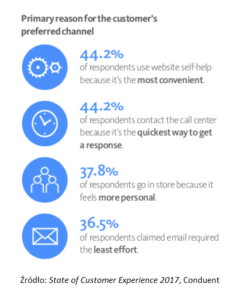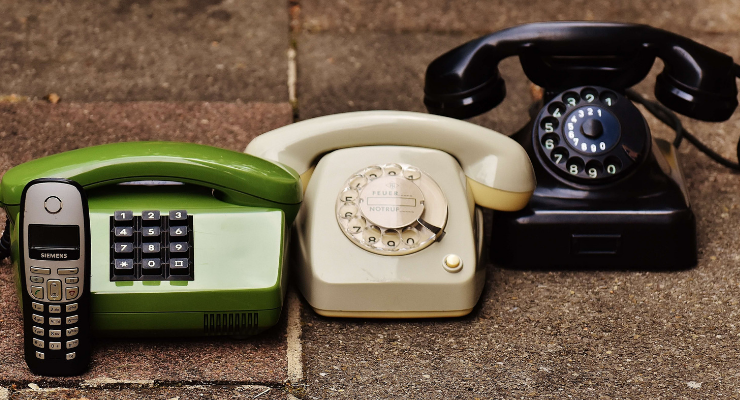E-mail, chat, self-search sites, telephone, Social Media – the more communication channels you offer to your client, the greater the chance that they will contact you directly. Even though that might seem obvious, the statistics show that most business owners don’t remember about it on a daily basis. What distinguishes the clients sending you emails from those who independently search the information on the website? What connects all those who choose telephone contact? And how to make each of these groups buy with you eagerly and more often?
In the previous post, we discussed three types of customers, divided according to their preferences for the choice of a communication channel when contacting your brand: a DIY hero, a digital conversationalist and a conversationalist. There are several factors influencing the way your customers prefer to contact your store: their own convenience, how fast it’ll get them the answers and the need – or lack – of personal interaction.
You have little influence on how your client chooses the communication channel. Knowing, however, what influences their selection, you can assure an appropriate level of customer service in a given channel.
Which communication channels does your client choose?
In a study conducted by Conduent, respondents rated various contact channels depending on the reason for choosing them. Why do some customers prefer calling than using a chat or vice versa? The answer to that can be found below.

Clients that value convenience chose FAQ sites
The FAQ and information on the website are most often chosen by those who are looking for the most convenient way to get answers. In addition, their choice of this information channel may be affected by their mood or their disclination towards an interpersonal contact. For this particular group of recipients, it is essential that the FAQ section on the site, as well as product descriptions and their photos, describe as many details as possible, are comprehensive and reliable. An e-client looking for information on their own is a convenient but also a very valuable customer. The fact that they entered your website and are looking for more detailed information is a sign that your offer is of interest for them. Take advantage of it, display similar or the most popular products, encourage them to subscribe to your newsletter and send offers corresponding to their preferences. This type of client is very likely to buy spontaneously, in a glance. Take care of the details, ensure quality pictures, as well as creative and interesting descriptions on the website, and the client will come back to you for more.
An impatient customer chooses a phone call
According to the study, a call center is considered to be the fastest means of contact with an online brand. No wonder – the client can quickly ask about a specific thing, and get a precise answer without the need for doing independent research. This factor needs to be remembered when giving training to your customer service team. People answering the phone calls need to have complete knowledge of the product/service (they shouldn’t make the client wait for an answer while they are looking for it), and an easy and full insight into the communication history with a given customer. Theoretically, these are the basic elements when training people working in a call center, but let’s look at a specific situation…
A customer calls an online clothing store and says:
- Customer: “Good morning, I am calling regarding the green jacket from the latest collection. Yesterday I placed an order and I just wanted to ask if you could please send me a red scarf as a gift instead of a green one. Is that ok?
- Agent: “Good morning, thank you for contacting us. Of course, that won’t be a problem, but can you please specify what jacket you have in mind? “
- Customer: “Well, the one you just posted on your Facebook page. Will you replace this scarf before you send the jacket? I’m not home and my battery will be gone soon. I really prefer the green one, so wanted to make sure I let you know before you ship it.
- Agent: “We will happily change the color of your scarf, but in order to do it we need you to tell us your order number.”
And so the minutes go by, the client’s phone dies, and the call center agent ends up frustrated and needing to review the entire facebook chat in order to identify the client. Meanwhile, the phone is still ringing, and there are more and more customers waiting in a queue. This conversation should have ended after one minute, which would save time for both parties involved as well as leave the client pleased and free of any worry regarding their order. What’s more, this conversation could have ended after a minute, if only the business was equipped with a simple tool that collects the history of contact with a given customer in one place. That would allow the call center agent to check who they talked on Facebook, what it was about, and thus meet their request immediately. Remember – a customer calling your store is of an impatient type. You have little time to make an impression on them, and that can turn out to be either positive or very negative. Good manners and precise answers are what decides of what their verdict will be.
A customer who needs personal attention chooses a stationary store
The third favorite channel of contact with a given brand is face to face. Clients choosing to visit your store in person are most often guided by the need of contacting people directly, getting personalized advice or by simply being used to dealing with matters in person. Nonetheless, customer service in a stationery store is a separate topic and this post focuses on online stores and services only.
A lazy customer chooses to send an email
E-mail is the fourth favorite channel of communication with a brand. The reason for email communication not being number 1 is that answers usually take longer to get compared to any other type of contact. Still, being the most convenient form of asking questions before making a purchasing decision, emailing remains very popular. What’s more, it does not involve any direct contact with another person, it can be sent anytime and anywhere, and you can still get a precise answer. It’s simple and convenient! We can deduct that emails are sent by those customers who are interested in your products but are not in a hurry to buy them. Take advantage of it! It’s a great way to find customers interested in extra products, special offers or getting feedback in return for a gift (e.g. “If you like our Facebook page/fill out a short survey, you will receive a 5% discount on the jacket you inquired about). Customers asking questions by email are a great focus group – use their time to better adapt your offer to their needs and thus generate more sales.





